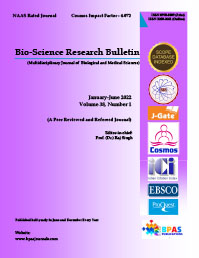Healing From Households: Urban Trees in the Management of Diarrhea and Dysentery in Ijesa Region, Nigeria
DOI:
https://doi.org/10.48165/Keywords:
Households, urban trees, Diarrhea dysentery, NigeriaAbstract
The perceptions of Ijesa people on Musa parasidiaca, Musa sapentum, Polyalthia longifolia and Psidium guajava identified for the management of diarrhea and dysentery were examined. Four respondents, that had maintained continuous domicile for minimum of 10years in Ijesa region, were purposively selected from each of 25 randomly selected communities and interviewed with the aid of semi-structured questionnaire matrix. The medicinal formula on these species, dosage utilization and perceived efficacies were determined. Respondents cut across varying socio-economic classes and were knowledgeable on the identified species. The use of the trees for medicine was perceived as free, readily available and extremely easy to prepare. The trees were cultivated primarily for purposes other than medicine. P. guajava and P. longifolia were valued for diarrhea while M. paradisiaca, M. sapientum and P. longifolia were valued for dysentery. Harvesting and use of stems in M. paradisiaca and stem barks in P. longifolia were annihilative and predatory while harvesting of leaves in P. guajava, flowers in P. longifolia and fruits in M. sapientum were not. The tree-derived medicine were described as very effective because they contained diverse phytochemicals however, pregnant women were disallowed from the use of extracts of P. longifolia as they are capable of inducing abortion. Secondary information revealed that diarrhea and dysentery have similar causal organisms, especially Shigella. Phytochemicals present in the identified tree species are capable of managing these causal organisms. Strategies that could further enhance medicinal values from urban forestry were prescribed.
References
Arborcarbon (2016). Benefits of urban trees-Infographic.
http://arborcarbon.com.au/benefits-of-urban-trees-infographic/
Adamant, A. (2018). 16 Medicinal Trees for Your Herbal Medicine Chest. https://practicalselfreliance.com/medicinal-trees/
Anon. (2020a). The best trees to reduce air pollution. Future Planet.
https://www.bbc.com/future/article/20200504-which-trees-reduce-air-pollution-best 4. Annon. (2020b).Is Banana a fruit or herb
https://www.lexico.com/explore/is-a-banana-a-fruit-or-a-herb
Buff, S. (2018). What is dysentery and how is it treated?
https://www.healthline.com/health/digestive-health/dysentery
Chah, K.F., C.A. Eze, C.E. Emuelosi and Esimone, C.O. (2006). Antibacterial and wound healing properties of methanolic extracts of some Nigerian medicinal plants. J. Ethnopharmacol., 104: 164-167.
Cole, A. T. and Kayode, J. (2020). Species Diversity in Urban Areas of Ijesa Region of Osun State, Nigeria. Bulletin of Pure and Applied Sciences, 38B (1):5-18
FAO (2020). Food from the forest.
http://www.fao.org/3/u5620e/U5620E03.htm
Felman, A.(2017) Everything You should know about dysentery. Medical News Today. https://www.medicalnewstoday.com/articles/171193
Hossain, M. S., Alam, S.B., Asadujjaman, M., Zahan, R., Islam, M. M., Ehsanul, M., Mazumder, H. and Haque, M. E. (2011). Antidiarrheal, Antioxidant and Antimicrobial Activities of the Musa sapientum Seed. Avicenna J Med Biotechnol.,3(2): 95–105.
Huguera, V. (2019). Chronic Diarrhea.
https://www.healthline.com/health/diarrhea/chronic-diarrhea
Imam, M. Z. and Akter, S. (2011). Musa paradisiaca L. and Musa sapientum L.: A Phytochemical and Pharmacological Review. Journal of Applied Pharmaceutical Science, 01 (05), 14-20. 13. Jiri, L. (2017). "The power of streetscape and how to protect it". Newcastle Herald. Newcastle NSW Australia.
Kayode, J. (2006). Conservation in Nigeria Perspective. Akolawole Press, Ado-Ekiti, 66pp. 15. Kayode, J. and Ogunleye, T. (2008). Checklist and Status of Plant Species Used as Spices in Kaduna State of Nigeria. Research Journal of Botany 3 (1): 35-40.
Lavanya, C., Rao, B. G. and Ramadevi, D. (2018). Phytochemical and pharmacological studies on Polyalthia longifolia. International Journal of Pharmaceutical Science and Research, 3 (4), 1-7. 17. McLaughlin, R. (2018). Plantain Tree.
https://dengarden.com/gardening/Plantain-Tree
Nair, R. and Chanda, S. (2007). In vitro antimicrobial activity of Psidium guajava L. leaf extracts against clinically important pathogenic microbial strains. Braz. J. Microbiol., 38, 452-458. 19. Ochoa, B. and Surawicz, M. (2002). Diarrhea: Acute or Chronic. American College of Gastroenterology.
https://gi.org/topics/diarrhea-acute-and-chronic/
Uddin M.S., Chowdhury V., Uddin S.B., Howlader, M.S. (2015). Ethnomedicinal plants used for the treatment of diarrhea and dysentery by the Lushai community in Bandarban district, Bangladesh. Journal of Advancement in Medical and Life Sciences, 2(4), 1-8.
WHO (2015) Water related diseases. World Health Organization, Geneva. Switzerland. https://www.who.int/water_sanitation_health/diseases-risks/diseases/diarrhoea/en/ 22. Yakubu,M. T., Nurudeen, Q. O., Salimon, S. S., Yakubu, O. M., Jimoh, R. O., Nafiu, M. O. Akanji, M. A., Oladiji, A. T. and Williams, F. E. (2015). Antidiarrhoeal Activity of Musa paradisiaca Sap in Wistar Rats. Evidence-Based Complementary and Alternative Medicine Vol. 2015, Article ID 683726, 9 pp. | https://doi.org/10.1155/2015/683726
